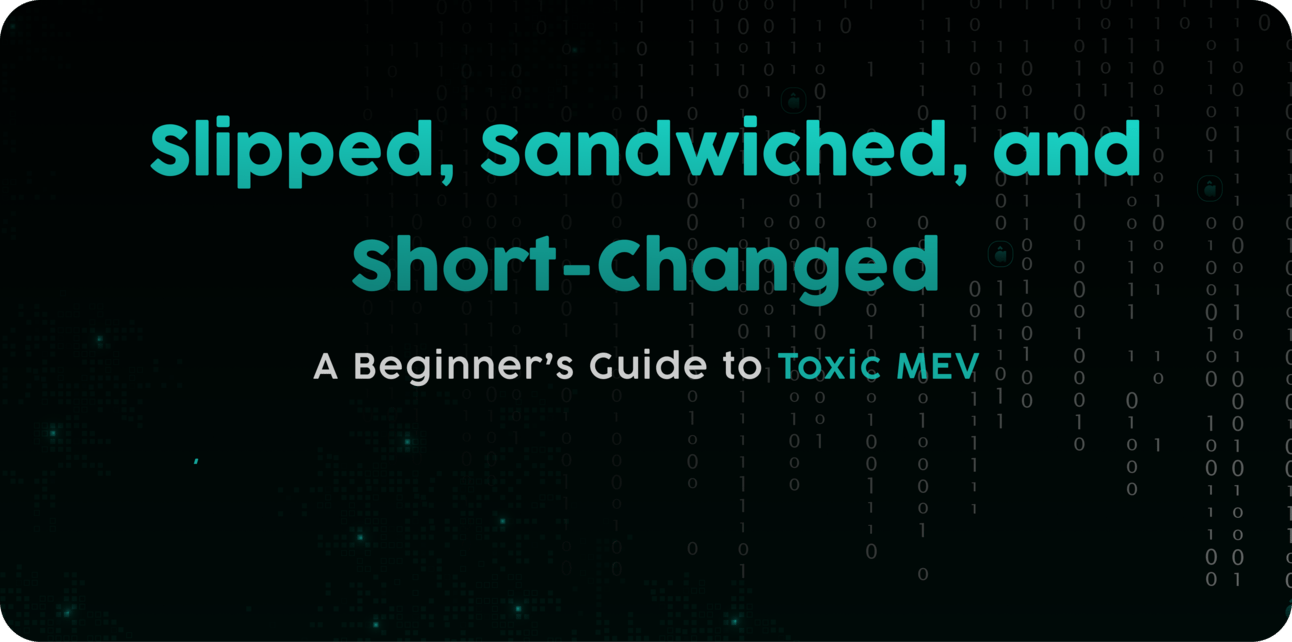- alpha unhashed
- Posts
- Slipped, Sandwiched , and Short-Changed A Beginner's Guide to Toxic MEV
Slipped, Sandwiched , and Short-Changed A Beginner's Guide to Toxic MEV



Maximal Extractable Value (MEV) lets insiders reshuffle the order of blockchain transactions and quietly skim profit. Some call it “market efficiency.” We call it what it is: a protocol bug that acts like an invisible tax on everyone else. Here’s the why, the how, and the fix.
In April 2024, an entire conversation about blockchain fairness changed — in just 12 seconds. Two MIT-trained brothers exploited a subtle flaw in Ethereum’s MEV-Boost relays, letting them peek at rival trading bots’ bundled transactions. With perfect timing, they inserted their own trades ahead of those bots, rewriting a block to walk away with $25 million — legally, and without touching a single smart contract’s code.
It wasn’t a hack in the traditional sense. It was a surgical manipulation of transaction ordering; a real-time heist, hidden in plain sight, that exposed how easy it is to game a mempool built for speed but not fairness.

MEV, short for Maximal Extractable Value, describes the extra money that block producers (validators or miners) and specialized trading bots can squeeze out of the system by controlling how transactions are ordered inside a block.
Think of it this way: when you place a trade on a decentralized exchange, it first goes to a shared public “waiting room” called the mempool. Anyone (including bots) can see these pending transactions. Whoever builds the next block gets to decide not only which trades to include, but in what sequence. That’s where MEV happens.
For example, a validator might:
> jump the line and buy before you (front‑running)
> box you in with a buy‑then‑sell combo that steals your slippage (sandwiching) or
> kick you out entirely if your trade blocks their profit (exclusion).
In effect, it acts like an invisible transaction tax, pulling value away from everyday users and rewarding those who control the block’s ordering.

Some argue MEV is just a sign of healthy free markets, aligning prices across exchanges. In reality, only a narrow slice of MEV (like basic arbitrage) does that. The rest, i.e., toxic MEV, acts more like an invisible tax, draining value from everyday users and warping incentives at the protocol level.
Let’s break down the real-world symptoms of toxic MEV:
symptom | why it hurts |
front-running | In TradFi, front-running is banned as market manipulation. On-chain, it’s routine, letting insiders get ahead of your trade with perfect transparency but zero fairness. |
negative-sum gas wars | Bots constantly outbid one another for transaction priority, wasting huge amounts of ETH on fees. That money doesn’t improve execution for users; it just evaporates. |
cartel risk | Running advanced MEV strategies takes custom infrastructure, data partnerships, and insider relays. Only a handful of powerful builders can manage this, concentrating profits and influence. |

> 2017–2019: Priority Gas Auctions (PGAs)
As blockspace demand surged, users spammed higher gas fees to get their transactions included, creating chaotic bidding wars and paving the way for opportunistic bots.
> 2020–2021: flashbots era
Private MEV bundles emerged, shifting MEV from public mempools into sealed deals with validators, reducing on-chain spam but centralizing influence.
> 2022: Proposer-Builder Separation (PBS)
after Ethereum’s Merge, PBS let validators outsource block construction, formalizing MEV markets with relays like MEV-Boost.
> 2023–2025: encrypted & intent-based systems
New ideas like threshold-encrypted mempools, batch auctions, and intent-based transactions aim to protect users by hiding transaction data until block finalization, reducing toxic MEV opportunities.
In short, DeFi is racing to tame MEV but the battle is far from over.

Developers, researchers, and protocols are fighting back against toxic MEV with new tools and coordination models. Here are five promising approaches:
> batch auctions (e.g., CoWSwap):
Process all trades in a single batch at a uniform price, removing the advantage of transaction ordering and killing sandwich attacks.
> threshold encryption (e.g., Shutter):
Encrypt transactions in the mempool until block finalization, so bots cannot preview or reorder pending trades.
> intent-based flow (e.g., SUAVE, Uniswap X):
Let users define what they want (like best price or guaranteed execution) and allow decentralized solvers to compete fairly, rather than racing the public mempool.
> private RPC routing (e.g., QuickNode Protect):
Send transactions through private gateways instead of the public mempool to keep them hidden from opportunistic bots.
> MEV-burn / reward smoothing:
Force block builders to burn or share a portion of extracted MEV, aligning incentives with user outcomes.
Together, these tools build a fairer foundation for DeFi’s next phase.

If you’re new to DeFi, it’s important to know that slippage and poor trade outcomes aren’t always random. Often, they’re the result of toxic MEV strategies exploiting your public transaction. Here’s how to protect yourself:
> use MEV-aware DEXs with batch auctions or intent-based execution.
> consider private RPC tools to keep your trades hidden from mempool bots.
> don’t assume higher gas guarantees fairness; ordering still matters.
> pay attention to slippage; extreme swings could signal sandwich attacks.
But the impact of MEV goes beyond individual wallets. Institutional investors (funds, corporates, and sophisticated traders) demand predictable, transparent, and fair execution. In TradFi, front-running is banned under rules like SEC Rule 10b-5 for a reason: it kills trust and blocks serious capital from entering.
If DeFi wants to scale beyond retail speculation, it must show that its rails are as fair and resilient as regulated markets. Cleaner execution layers, enforced through MEV-resistant protocols, will unlock deeper liquidity, attract long-term players, and help decentralised finance fulfill its promise.

Beyond personal trading strategies, investors and analysts should also watch for signals at the protocol level. Here’s a fast due-diligence checklist to help separate robust projects from risky ones:
green flags | red flags |
decentralized block builders with transparent relay access | block production dominated by a small cartel or closed relays |
incentives that reward long-term user retention | protocol profits tied to toxic MEV extraction or priority fees |
strong community governance over transaction ordering | order flow controlled by opaque, private validator deals |
verifiable audit trails for MEV strategies | no transparency around who captures block rewards and MEV |
In addition to personal trades, fairness is also an investable trait at the protocol level. Projects building around clean, user-aligned execution are far more likely to scale sustainably and attract serious capital.

At aarnâ, we see fair blockspace as core protocol alpha. That’s why we route trades through QuickNode Protect and other private RPC endpoints, minimizing exposure to sandwiching and latency sniping in the public mempool. Beyond safeguarding user flow, we actively back open-source primitives like threshold encryption, batch auctions, and intent-based execution to make blockspace credibly neutral.
By leaning into MEV-aware infrastructure and supporting public goods, aarnâ helps keep block-building transparent and user-aligned. Clean flow isn’t just good UX; it’s what scales DeFi for the next cycle and beyond. Fair ordering is the competitive moat for on-chain finance.

MEV will never fully disappear, but its most toxic forms don’t belong in a fair, permissionless future. Predatory transaction reordering is a protocol bug, not a feature, draining trust and value from the ecosystem. By adopting MEV-aware tools like encrypted mempools, batch auctions, and intent-based routing, we can realign incentives and push value back to where it belongs: builders, traders, and the communities who create it.
If DeFi wants to scale into the next decade, fair execution can’t be optional. It’s time to coordinate, ship MEV-resistant architecture, and defend user flow from rent-seeking. Clean blockspace is the real alpha; let’s build it together.
aarnâ is now on iOS & Android! Download now and experience the future of finance on your phone!
disclaimer:
this newsletter is for informational purposes only and should not be considered financial or investment advice. The information provided does not constitute a recommendation to buy, sell, or hold any digital asset or engage in any specific DeFi strategy. always conduct your own research and consult with a qualified financial advisor before making any investment decisions. know more
Gain an edge in DeFi alpha with aarnâ’s AI-driven insights and DeFi vaults. Try the dApp now.

